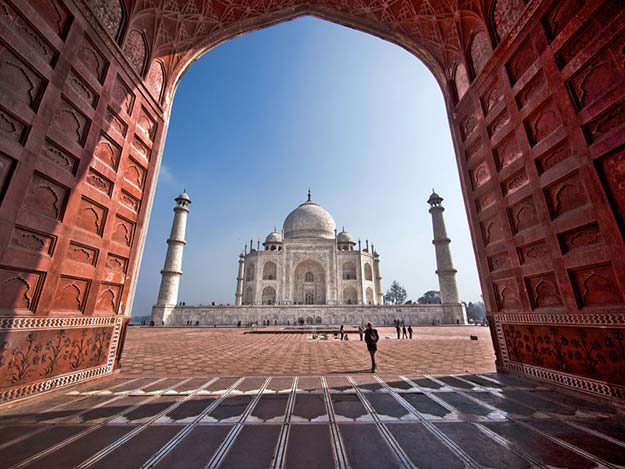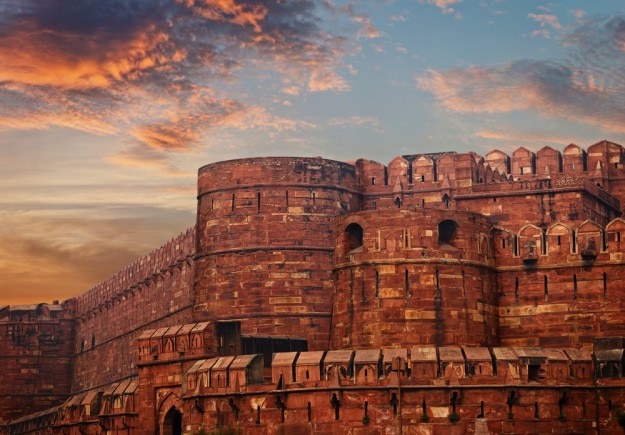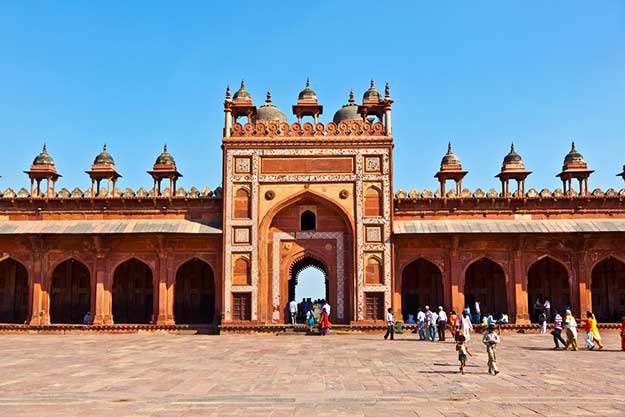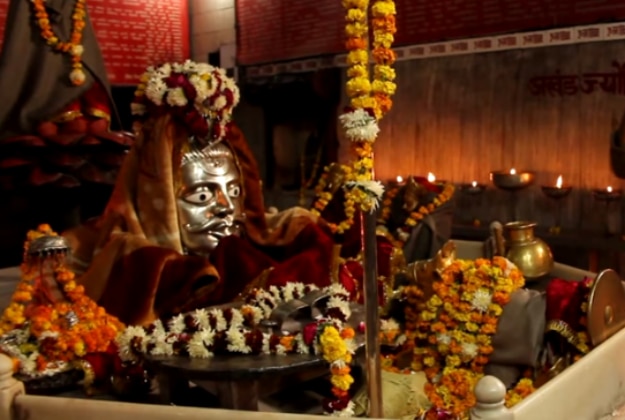The city of Agra is often ranked among India’s top picks for vacationers. It is well known for being the location of the Taj Mahal, which is considered to be one of the Seven Wonders of the World. It is admired not just by people from India, but also by people from other countries, who come here in big numbers to take in its stunning scenery. Agra is part of what is known as India’s “Golden Triangle,” which also includes the cities of Delhi and Jaipur. Agra, which is located in Uttar Pradesh, is most known for being home to the Taj Mahal; however, there is a great deal more to the city than just this internationally renowned structure. From the time of the great Indian epic the Mahabharata through the reign of the Mughal dynasty, Agra has been a historic city that has played an important part in the development of Indian history. The name Agrevana, which translates to “the edge of the forest,” is the name given to the city for the first time in the Mahabharata. Later, in the sixteenth century, it was founded by Sikandar Lodi of the Lodi Dynasty, who was also responsible for the construction of numerous buildings in Agra, such as forts, step wells, mosques, and so on. After his death, his son took over as ruler of the city, and for those nine years, Agra became the new seat of his empire. Later, Sher Shah Suri governed Agra, and the city served as the capital of the Mughal Empire between the years 1556 and 1658.

Taj Mahal, Agra
During the time of the Mughal dynasty, when famous people like Akbar, Jehangir, Shah Jahan, and others were in charge, Agra changed its name to Akbarabad. Their enthusiasm for architectural design, horticulture, art, and culture all contributed to the development of Agra’s distinct personality. During their rule, the city of Agra went through its golden age, as shown by the fact that Persian gardens were built on the banks of the Yamuna, along with monuments and mausoleums. In the years following the fall of the Mughal Empire and during the time when the Marathas were in control of India, Akbarabad was renamed Agra. In the year 1803, it was included into the British Raj, which maintained its power for the most part up to India’s independence in 1947.
Agra’s culture was also shaped by the various religions that took root and flourished in this city during the city’s history. From Din-i-Ilahi to the Radhaswami Faith, each of these schools of thought had adherents during the time of Akbar. Agra is also connected to Runukta, which is part of Hinduism, and Shauripur, which is part of Jainism.
Agra is the location of numerous significant structures, including three UNESCO World Heritage Sites: the Taj Mahal, Agra Fort, and Fatehpur Sikri. The city has been controlled by a large number of influential monarchs throughout its history. Your vacation to Agra is not complete unless you pay a visit to these sites, which will transport you to an earlier time in the city’s illustrious history.
GETTING THERE
Because Agra is such a popular place for tourists to visit, it has great access to all kinds of transportation, such as roads, trains, and airports. Surprisingly, it takes 210 kilometers to get to Lucknow, which is the capital of the state, while it only takes 125 kilometers to get to Delhi. The city is on the banks of the River Yamuna and gets a good number of tourists all year long.
There are cabs available once you land at Kheria Airport in Agra, which is located 12.5 kilometers distant from the city’s central business district. Agra Cantonment, Agra Fort, Idgah Agra Junction, and Raja ki Mandi are the city’s four most important railway heads in order of prominence. One of these train stations is visited by trains coming from the majority of cities. Tourists have the option of taking India’s quickest train, the Gatimaan Express, which travels the distance between Delhi and Agra in exactly one hundred minutes. Additionally, it provides travel plans that may be selected for one, two, or three days. You may also make your way to Agra by car from several locations within the county. There are a number of ways to get to Agra from Delhi, but one of the quickest is through the Yamuna Expressway. Even if you don’t own a car, you can take advantage of the taxis and other private transportation options that run along this highway. Agra may also be reached by bus from major towns like as Delhi, Lucknow, Jaipur, and Gwalior. The Taj Depot, the Inter State Bus Terminal, the Ford Depot, and the Idgah Bus Stand are the most important bus stations in the city. Because tourism accounts for such a significant portion of the state’s revenue, the government has taken steps to make it as easy as possible to go to Agra.
SIGHTSEEING ATTRACTIONS IN AGRA
Agra was the seat of the Mughal Empire and is peppered with some great architectural marvels of their times. While Taj Mahal garners the most amount of interest, when in Agra, it is important to pay a visit to some of the city’s other exemplary structures. Once you are done admiring the wonder that is Taj Mahal, move on to other important sites, some in its vicinity and some a little further away from it. From Akbar’s Tomb to Agra Fort and the walled city of Fatehpur Sikri, Agra is home to some important monuments that tell the story of India’s history. Take a day out to explore these gems that Agra has to offer.
Taj Mahal

The very first thing every tourist who comes to Agra wants to do is see the beauty that is Taj Mahal. No matter how many times you’ve been here, it will leave you mesmerized with its intricate carvings and architecture. The Taj Mahal is certainly the main attraction that draws millions of tourists to Agra every year and rightly so. Called the epitome of love, it was constructed by Shah Jahan for his beloved wife Mumtaz Mahal whose tomb rests right under the central dome of the monument. It took 22 years and over 20,000 workers to construct this marvel. Shah Jahan spent his last years imprisoned in the Agra Fort gazing at his creation and after his death, his tomb was placed inside the Taj Mahal next to his wife. The white marble monument is an architectural marvel with fine detailing, on the south bank of the Yamuna River. Verses from the Holy Quran are inscribed on it, gemstones adorn its walls and the intricate inlay work adds a touch of magnificence to the structure. Another brilliant fact that makes it a masterpiece is its symmetry, which is why it looks the same from all four sides.
Being one of the Seven Wonders of the World and the only one in India doesn’t stop from wrong stories floating around the Taj Mahal. Ones like the Taj Mahal was also to be built in black marble or that Shah Jahan dismembered the arms of the artisans who built the monument are pretty common but not really true. But one true and fascinating story is that Agra was not the first choice to build the Taj Mahal. Yes, the world famous monument was originally planned to be constructed in Madhya Pradesh in Burhanpur because Mumtaz Mahal passed away there. Shah Jahan had even marked out the site along the Tapti River where it was to be built but the plan was shelved when Burhanpur was unable to supply enough white marble that was required for its construction. And so, Agra got its iconic monument that we call the Taj Mahal.
Admire its striking beauty yourself when here. The Taj Mahal is open for visitors between 6 am to 6 pm but remains shut on Fridays. The entry fee for Indians is Rs 20 and for foreign nationals it is Rs 750. According to one legend, if you walk away from the Taj Mahal and look back, you are likely to come back for another visit. Would you?
Agra Fort

The Agra Fort, a UNESCO World Heritage Site, is another architectural gem in this city. Mughal Emperor Akbar erected it with the aid of 4,000 workmen who labored for eight years to complete it in 1573. The Mughal Empire’s seat was Agra Fort, which was built of red sandstone. Structures like as the Sheesh Mahal, Moti Mahal, Jehangir’s Palace, and Khas Mahal are among the key sights of Agra Fort that will captivate you. The fort includes four enormous gates, one of which was utilized for the king’s official entry. The Diwan-i-Khas and Diwan-i-Aam were designated for the royal audience and the general populace, respectively.
During the Mughal Empire, Agra Fort was important. Even though Akbar built it, Shah Jahan refurbished it during his reign by adding marble work and transforming the rough red sandstone edifice to a palace. Years later, his son Aurangzeb imprisoned him in Mussaman Burj, the same fort. Visit this section of the fort because it has one of the greatest views of the Taj Mahal. Despite these alterations, Agra Fort is a masterpiece of Mughal architecture and should not be overlooked.
Tourists can visit Agra Fort from 7 a.m. to 6 p.m. every day of the week. The admittance price is Rs 20 for Indians and Rs 300 for visitors. It is spread out over 94 acres, so you will need around two hours to fully examine the monument.
Fatehpur Sikri

One of Emperor Akbar’s pet projects was building a walled city a little away from Agra. He called it Fatehpur Sikri and even ruled here for sometime before he was forced to move out due to shortage of water supply. Nevertheless, the surviving monuments tell a tale of his valour and great work. Fateh in Persian signifies victory. The city survived and three of its walled sides are still intact. Akbar paid keen interest in its architecture and layout and it took about 15 years to plan and build it completely. Once ready, it had palaces, harems, buildings, courts and a mosque. But one of the best architectural wonders of Fatehpur Sikri is the Buland Darwaza, a grand gateway to the walled city. Made of red sandstone, there are 52 steps that lead up to its 175 ft high archway that has two inscriptions. Akbar’s favorite minister Birbal too has a monument in Fatehpur Sikri called Birbal’s house. Since he was a Hindu, the architecture is different than the usual Mughal buildings.
One of the first buildings to be constructed in Fatehpur Sikri was the Jama Masjid, a mosque built according to Indian mosque architecture. It also houses the tomb of Salim Chishti, a great Sufi saint. Akbar, who was the founder of the faith Din-e-Ilahi also constructed Ibadat Khana in Fatehpur Sikri which was used for meetings. The Panch Mahal, a five-storey palatial structure was for the ladies and the Naubat Khana that had drummers announce the entry of the emperor were other unique structures in this city. Despite the lavish architecture and careful planning, Fatehpur Sikri was abandoned in 1585 after ruling it from 1571. This was because the lake that supplied water to the city dried up. Even so, it is worth marvelling the beauty of what a magnificent city this once was. Fatehpur Sikri is about 37 km away from Agra but can be completed on the same trip. Most of the city lies uninhabited and reminds one of its once glorious past. You can find a few budget hotels to stay at near the Fatehpur Sikri Railway Station. Don’t miss visiting this place as it is another UNESCO World Heritage Site.
Emperor Akbar’s passion project was to establish a walled city outside of Agra. He named it Fatehpur Sikri and even reigned from there for a while before being forced to leave owing to a lack of water supplies. Nonetheless, the monuments that have survived convey the story of his bravery and remarkable accomplishment. Fateh means triumph in Persian. The city survived, and three of its four walls are still standing. Akbar was particularly interested in its design and arrangement, and it took roughly 15 years to construct and build. It had palaces, harems, houses, courts, and a mosque when it was finished. The Buland Darwaza, a great entryway to the walled city, is one of Fatehpur Sikri’s best architectural treasures. There are 52 steps leading up to the 175-foot-high archway, which is made of red sandstone and features two inscriptions. Birbal, Akbar’s favorite minister, has his own monument at Fatehpur Sikri named Birbal’s House. Because he was a Hindu, the architecture differs from typical Mughal structures.
The Jama Masjid, a mosque built in the style of Indian mosques, was one of the earliest buildings to be built in Fatehpur Sikri. It also holds the grave of Sufi saint Salim Chishti. Akbar, the founder of the Din-e-Ilahi religion, also built Ibadat Khana in Fatehpur Sikri, which was utilized for gatherings. The Panch Mahal, a five-story royal structure for the ladies, and the Naubat Khana, which had drummers proclaim the emperor’s arrival, were two more notable constructions in this city. Fatehpur Sikri was abandoned in 1585 after governing it since 1571, despite its rich grandeur and careful design. This was due to the drying up of the city’s water supply lake. Even so, it’s worth admiring the splendor of what was once a wonderful metropolis. Fatehpur Sikri is roughly 37 kilometers from Agra and may be visited on the same day. The majority of the city is deserted and serves as a reminder of its formerly brilliant history. There are a few inexpensive hotels near the Fatehpur Sikri Railway Station. This is another UNESCO World Heritage Site that should not be missed.
The Tombs of Akbar
During his reign, Akbar the Great erected various magnificent monuments, one of which was his own mausoleum. The task of commissioning your own tomb is a Turkic custom that the Mughals followed. He even chose the location where he would be held. Akbar’s Tomb is located at Sikandra, his last resting place. In 1613, his son Jehangir finished building his father’s mausoleum, which was finely carved and built of red sandstone. Mariam’s Tomb, Akbar’s wife and Jehangir’s mother, is only 1 mile away from Akbar’s Tomb. The monument is available to the public from 6 a.m. to 6 p.m. every day of the week. The admission price is Rs 15 for Indians and Rs 110 for visitors.
The Mehtab Bagh
Mehtab Bagh, which translates as “moonlight garden,” is an ideal location for appreciating the Taj Mahal’s magnificence. It is a square garden built by Babur that was formerly adorned with lakes, fountains, and trees. It is now a popular tourist destination. It is a Mughal garden along the Yamuna River that is perfectly aligned with the Taj Mahal and was touted by Shah Jahan as the finest site for viewing the Taj Mahal.
The garden was in ruins by the 1990s due to recurrent floods and locals’ exploitation of construction materials. The Archaeological Survey of India (ASI) intervened, however, and efforts to restore the garden to its former state began. They even made certain that the flora utilized in Mehtab Bagh were genuinely from Mughal gardens. Guava, Ashoka, jamun, neem, hibiscus, and other plants were among them. There were four sandstone towers in the garden as well, but only one exists now. Other structures that were not originally a part of Mehtab Bagh were erected during the renovation. Among these are a statue of BR Ambedkar holding the Indian constitution, a temple, and nurseries. Mehtab Bagh is open every day of the week from 6 a.m. to 7 p.m. The admittance price is Rs 5 for Indians and Rs 100 for international citizens.
Mankameshwar Mandir

One of the ancient Shiva temples in the country, Mankameshwar Mandir holds much religious importance as according to the legend, Shiva installed a lingam here on his own. The Mughal architecture isn’t the only thing that draws tourists to Agra, temples like these are also crowd-pullers. The temple is close to Agra Fort and near other tourist monuments like the Taj Mahal. As per the legend, Shiva wanted to go to Mathura after the birth of Krishna to get a glimpse of the little baby boy. During his descent from Mount Kailash, he rested and meditated at the sight of this temple and declared that if he is able to reach in time to see Krishna, he will install his swaroop here. And so, on his way back he kept his word and there was a lingam here covered in silver.
Today, Shiva devotees come from different parts of the county to pay a visit to this temple. People have to climb down a flight of stairs to reach Mankameshwar Mandir’s sanctum sanctorum. It is surrounded by other idols of Shiva’s family and there are more temples behind this temple’s complex dedicated to other gods like Saraswati, Krishna, Hanuman and more.
When here, you can light a deepak and make a wish as the temple gets its name from a wish-fulfilling temple that Shiva himself created. Also, try the paan outside which is usually triangular and covered in silver foil. Mankameshwar Mandir is open on all days from 7 am to 10 pm and entry to the temple is free for all.


0 Comment